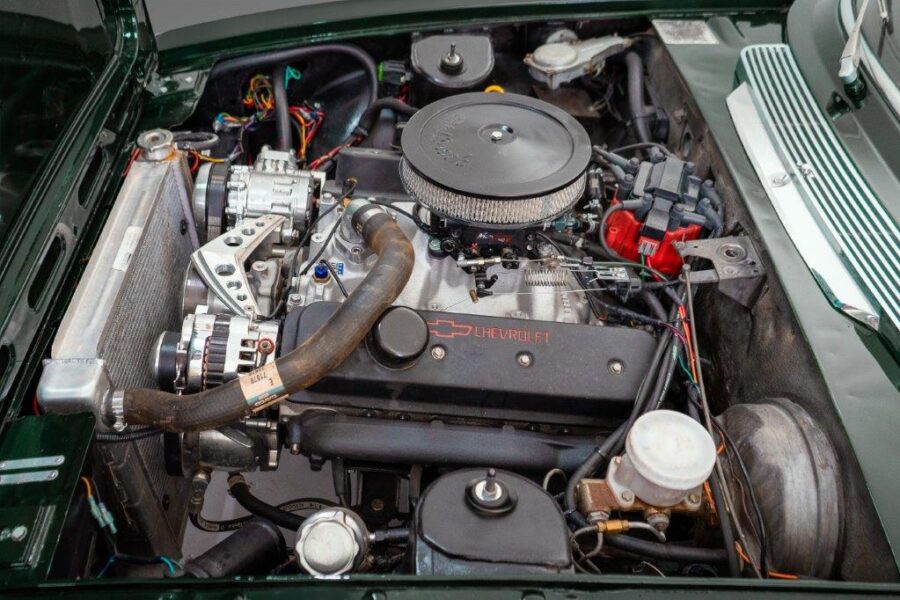

1971 Triumph Stag Restomod
Click any photo to view fullscreen. Mobile users can pinch to zoom. Tap ‘X’ to close.
SPEED
SPECIFICATIONS
- Complete As New Resto-Mod by Performance Center of Jupiter, FL
- 383 ZZ4 crate motor
- Turbo 350 automatic transmission
- Customized 9in ford rear end Posse 3.70 gear
- 4wheel power disc brakes
- Front and Rear Custom ladder Bars and Connectors
- Power Rack and Pinion Steering
- Custom Air Conditioning
- Aluminum fuel cell
- Custom Hood
- Aluminum radiator
- Custom replica wheels
1971 Triumph Stag Restomod
Envisioned as a luxury sports car, the Stag was designed to compete directly with the Mercedes-Benz SL class models. All Stags were four-seater convertible coupés, but for structural rigidity – and to meet proposed American rollover standards of the time – the Stag required a B-pillar “roll bar” hoop connected to the windscreen frame by a T-bar. A body color removable hard top with defrost wires on the rear window, full headliner and lever operated quarter windows was a popular factory option for the early Stags, and was later supplied as a standard fitment.
The car started as a styling experiment cut and shaped from a 1963–64 pre-production 2000 saloon, also styled by Giovanni Michelotti. His agreement was, if Harry Webster, Director of Engineering at Triumph, liked the design, Triumph could use the prototype as the basis of a new model. Webster loved the design and took the prototype back to England. The end result, a two-door drop head (convertible), had little in common with the styling of its progenitor 2000, but retained the suspension and drive line. Triumph liked the Michelotti design so much that they propagated the styling lines of the Stag into the new T2000/T2500 saloon and estate model lines of the 1970s.
Triumph gave new projects four letter development code names (e.g. Bomb for Spitfire) and interestingly, Stag was the only Triumph to take its development code name into production.
The initial Stag design was based around the saloon’s 2.5-litre six cylinder engine, but Webster intended the Stag, large saloons and estate cars to use a new Triumph-designed overhead cam (OHC) 2.5-litre fuel injected (PI) V8. In 1968, under the direction of Webster’s successor, Spen King, the new 2.5 PI V8 was enlarged to 2,997 cc (3 L; 183 cu in) to increase torque. To meet emission standards in the US, a key target market, the troublesome mechanical fuel injection was dropped in favor of dual Zenith-Stromberg 175 CDSE carburetors. In common with several other manufacturers, a key aim of Triumph’s engineering strategy at the time was to create a family of in-line and V engines of different size around a common crankshaft. The various configurations Triumph envisaged would enable the production of four-, six-, and eight-cylinder power plants of capacity between 1.5 and 4 litres, sharing many parts, and hence offering economies of manufacturing scale and of mechanic training. A number of iterations of Triumph’s design went into production, notably a 2.0-litre slant four-cylinder engine used in the later Dolomite and TR7, and a variant manufactured by Stan Part that was initially used in the Saab 99. The Stag’s V8 was the first of these engines to be fitted to a production car. Sometimes described as two four-cylinder engines conjoined together, it is more strictly correct to say the later four-cylinder versions were the left half of a Stag engine.
As in the 2000 model line, unitary construction was employed, as was fully independent suspension – MacPherson struts in front, semi-trailing arms at the rear. Braking was by front disc and rear drum brakes, while steering was power-assisted rack and pinion.
July 2017, 91% of Stags known to DVLA had a 3-litre engine, according to www.howmanyleft.com. It is not clear how many of these are original Stag engines and how many are Ford 3-litre
Electric windows, power steering and power-assisted brakes were standard. Options included Delaney Galley air conditioning, a luggage rack, uprated Koni shock absorbers, floor mats, and Lucas Square Eight fog lamps





